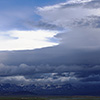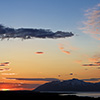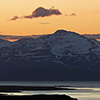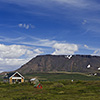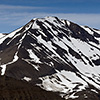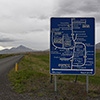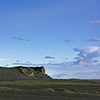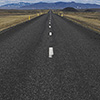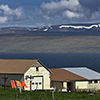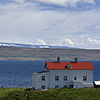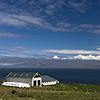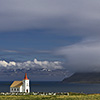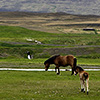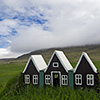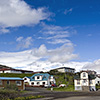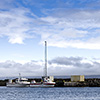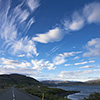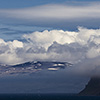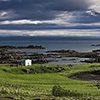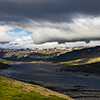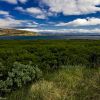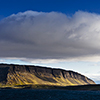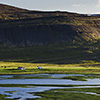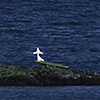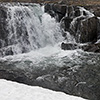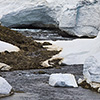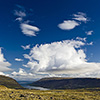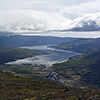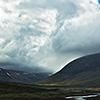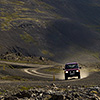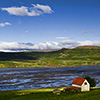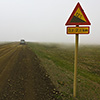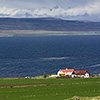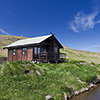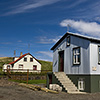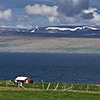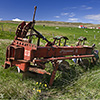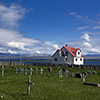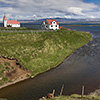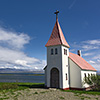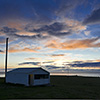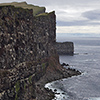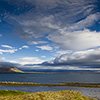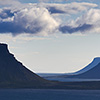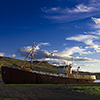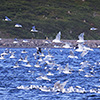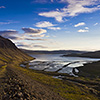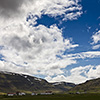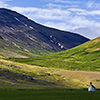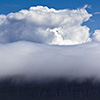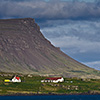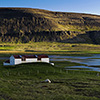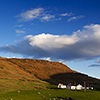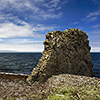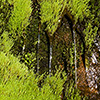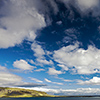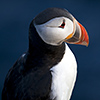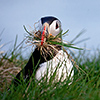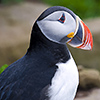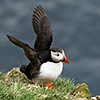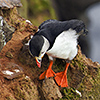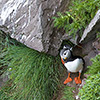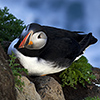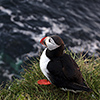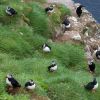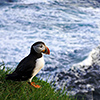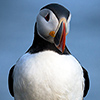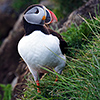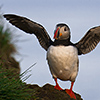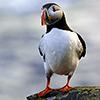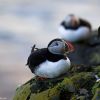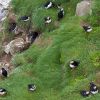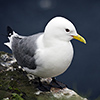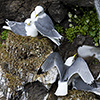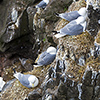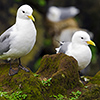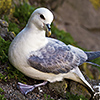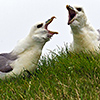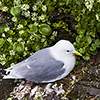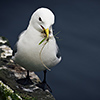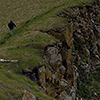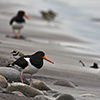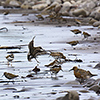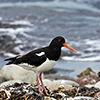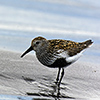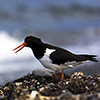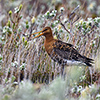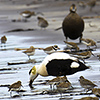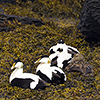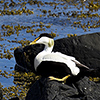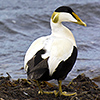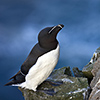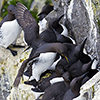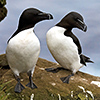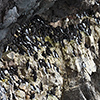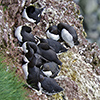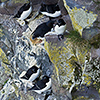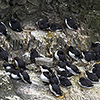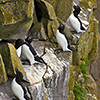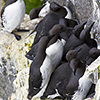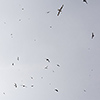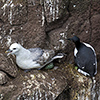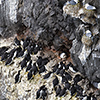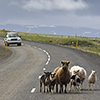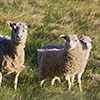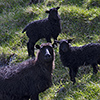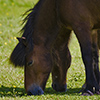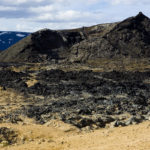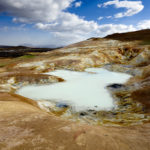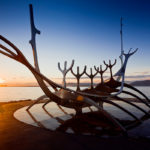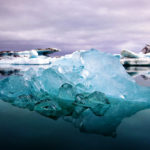Thousands of Sea Birds and dramatic Cliffs – On the way in the Westfjords
The Westfjords are Iceland’s most remote part of the country. It is not only in the back of beyond, but also a home for countless sea birds hunting for fish and raising their families. The always changing light situation in the narrow fjords surely won’t let you drive straight from A to B as behind every corner there’s another scenic amazement that lets you stop anew and enjoy.
Following the ring road #1 from Bakkaflöt valley my journey went on westwards to tour the Iceland’s Westfjords. To do that road #61 is a perfect beginning, as it introduces the changing landscapes step by step. Scenically seen actually everything in Iceland is a highlight and there is actually no chance to name a favourite place, but the beauty of the Westfjords is highly appreciated as there that typical Scandinavian and Nordic-rough character can be experienced. As distinct from the relatively wide fjords in the North-East, the bays and mountains of Iceland’s west are a bit like Norway en miniature. The water is crystal clear and its blue colour even reminds of the Caribbean while the fjords’ crags are often covered by lush green meadows and don’t remind that much of the brownish-white polar regions. No surprise that here the world of birds is breaking all records called quantity.
Between Guðlaugsvik and the Fjardharhorn farm road #61 is most interesting. Sometimes it leads you over sharp ridges and through thick cumulus clouds which immediately cool you down. Sometimes it also follows the coast line, then you drive only a few meters away from the Ocean; an ideal position to watch Eider ducks from the pillion. The hilly landscape is dominated by lots of pasturages. Respect the fence, even when there is nobody in sight. These pasturages are basically to feed the sheep; for us Central Europeans those animals must be countless. Well, they definitely are countless, but also their count dropped significantly. Once it Iceland was crowded by 20 sheep per Icelandic head, now it is only 5, maybe even only 4.
During spring the boys and girls of Vegagerdin, Iceland’s road administration, are step by step giving clearance to the higher placed north-south routes. So they did for branch road #608, a gravel road passing. It branches off the #61 after Hólmavík, a fishing town where you can have another stop to refuel car and stomach. The southern road #608 ends in several wide serpentines; descending down on them to the foot of Þorskafjörður fjord is absolutely spectacular.
The ridge that is crossed by #608 is not an easy one. While being flanked by ice on the left and right side, the road is quite windy and a hell of gravel, which gets constantly catapulted up by the car’s 4×4. That surely causes some serious thoughts if the car rental will charge you for complete new paint… Potholes as deep and big as if half a cow could hide itself in there are another cheeky thing when on the opposite “track” traffic appears; especially locals often pass and overtake others with a speed of 60km/h or more.
The roads in the western fjords often lead through towns often not exceeding a count of 20 inhabitants. Once you meet an interesting motif again, by a smile and friendly waving a simple stop can develop to a human meeting between Fire Island and Central Europe.
Spending a night at Cape Bjargtangar on the Látrabjarg peninsula, Europe’s westernmost cape point was on my mind. Well, westernmost in a political meaning, as technically and geographically seen that point is already on the American continental plate and about 200 kilometres far away from the Mid-Atlantic Ridge. Sometimes you meet no living soul when driving in Iceland; even if Iceland is quite small, it is kind of a miracle that I met Henry and his girlfriend Solveig again. Spontaneously we joined forces to enjoy the amazing mix of blue sky, ice clouds and sidelight photographically and to spend the night at Látrabjarg together.
At six o’clock in the evening again that amazing sidelight of the setting sun appeared. A kind of light, that kept us photographers on the go for five hours without reaching the final destination. Once you finished gazing in amazement at the one fjord, the next entirely different and absolutely brilliant landscape already awaited you around the next corner. Between Látrabjarg and Rekyhólar road #60 is one of the most beautiful routes I have ever driven. Here and there that road even has dangerous hill, being steep 16%. That’s some amazement for you driving abilities as well. The coastline of the rugged Westfjords makes up 30% of Iceland’s entire coastline.
The southern coast of Látrabjarg is turned to the south and is dominated by a 14 kilometres long front of bold cliffs, culminating in 441 meters high Heidnakinn cliff. Almost every rock shoulder, any possible place to stay is occupied by myriads of sea birds. Among them are lots of razorbills, seagulls (of course) as well as thick-billed murres, a far congener of the penguin, but able to fly. However, the star and most watched attraction is the Lundi, how a puffin is called by the Icelanders. Right after arriving at Látrabjarg’s beacon my personal dream of Iceland came true, when I spotted that little black-white head curiously looking out of the grass. A vivacious beak, faithfully looking button eyes and small red waddling legs – you would love nothing better than taking one of them back home.
When looking over the cliff’s edge then my look got returned by hundreds of these curious little guys. To boot, and unlike whooper swans and grey goose, you can get really close to them. They escape only if the situation becomes too strange or you get too fast too close. I am sure that when you speak and socialize with them, then surely petting a Lundi is quite possible.
Most impressive are the rocks where the black-legged kittiwakes are breeding. In distinction from gruff looking fulmars and even more unlikeable Skuas, the kittiwakes have a very beautiful plumage, which has a silvery shine if the sun comes out. Their nests seem to be literally glued to the rocks. After the hatchlings see the light of the day, the old bird also serves as a natural barrier between sheer rocks and yawning chasm.
The extremely steep cliffs are literally shitty and the whole region smells a bit like an uncleaned hamster cage. No worries, a fresh breeze solves that “problem” as a rule. Getting close to the edge isn’t that hazard-free since the rocks on top of the cliff could fall down and take them with you. Lying there on your belly is the safest way to watch the feathered madding crowd. Another advantage of that posture is that you are not standing in the seagulls’ air corridor. These birds are good aviators, but when flying in a swarm of 100 birds sometimes space for dodging is missing.
Quickly you will meet the photographer’s best friend; the oystercatcher. Once trying to creep up on shy Eider ducks or attentive grey goose again, at the latest that black-haired bloke with red shoes and long beak makes things become tottering. A short but loud “Peep!” and ducks as well as goose are up and away. Presumably only God knows why one of these little guys is breeding always close to you, that is soooo often right next to the roadside…
Speaking of right next to the road… Not always sheep remain behind the fence. There are reasons why the Icelandic Police warns of animals suddenly stepping on the roads. That reaches from sheep, over horses to even cows and big swarms of seagull warming up their feet.
One big problem when travelling the western fjords is finding a toilet. Well, there are some road houses, but only few of them. Most remote places like Cape Bjargtangar don’t have a toilet at all. If you have to pay an urgent visit, then doing what has to be done will be a natural thing. When asking around for a toilet a farmer answered bluntly: “A toilet??? Boy, we surely got a toilet somewhere here… But, do you really think all that in the grass is coming from sheep? :-)”
At Europe’s westernmost end you can be in peace with the world and yourself when experiencing and enjoying a breath-taking authentic combination of nature, landscape and weather. The Westfjords are famous for their weather… This advertising cuts both ways. When the sun is shining, then it is one of the most beautiful places on Earth. But within only one hour the situation can completely change and rain and wind are taking over. Wind force 10 as well as 4° Celsius and cold rain are everything else than inviting.
Back in 1947 the British trawler Dhoon ran aground due to a sudden weather change. The people of Hvallátur immediately started a rescue operation, abseiled themselves from the cliffs and saved 12 seamen from death. The year after a film team wanted to re-enact that occurrence for a documentary. While they were putting up the backdrop and film set another British trawler hit the coast, this time near Patreksfjörður. As for navigation unlucky but in terms of filming very lucky the rescue operation following that accident could be filmed live and used later in the documentary that got released under the name Rescue Deed at Látrabjarg.
A visit to Iceland’s Westfjords is a life time experience of all things called feathered biodiversity; but above all it stands for a certain maritime feeling of freedom.
